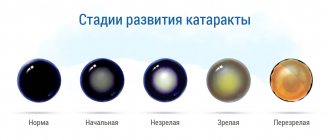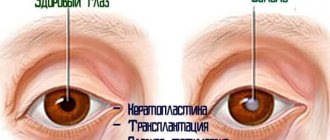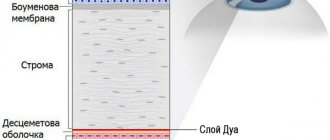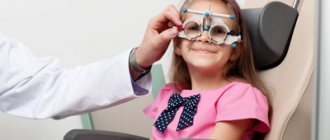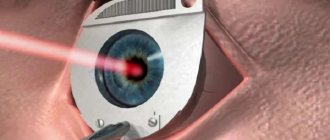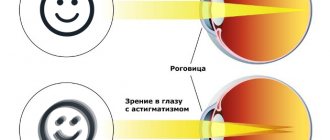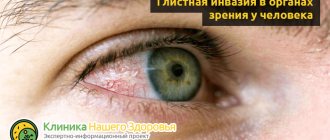The ancient Greek philosopher Aristotle was the first to guess about the existence of myopia in the 4th century BC. He noticed that some people have difficulty distinguishing distant objects and, in order to see better, squint their eyes. Aristotle called this phenomenon “myops,” which means “squinting” in Greek. Modern eye doctors remember this, which is why they prefer to use the term “myopia” instead of myopia.
Myopia (myopia) is a visual impairment in which a person sees objects located at a close distance well, but poorly objects distant from him. Myopia is extremely common: according to statistics, every third inhabitant of the Earth suffers from it. Typically, the disease begins to develop between the ages of 7 and 15 years, and then either worsens or remains at the same level.
Causes of myopia
Myopia is described as a disproportion between the optical power and the length of the eye. When light rays penetrate the cornea and lens, they focus on the retina of the eye, producing a clear image. But when the center of the image located in front of the retina shifts, vision deteriorates and the person develops myopia.
It is very important to know the causes of myopia in order to choose the most effective methods of treating it. Accurate identification and elimination of the causes of the disease is a guarantee of recovery. The most important of them are the following:
- Excessive elongation of the eye, causing the focus of the retina to shift. The size of the eye of a healthy person is usually 23-24 millimeters, and in people with myopia it is much larger, and can reach 30 millimeters.
- Quite strong refraction of light rays by the lens and cornea of the eye.
- Hereditary predisposition – gives the greatest likelihood of acquiring the disease. The risk of a child inheriting the disease can reach 50 percent if both parents have myopia.
- Various head injuries, concussions, problematic childbirth.
- The presence of increased intracranial or intraocular pressure.
- Lack of particularly important vitamins B and C in the body, various microelements: magnesium, manganese, copper and zinc. These substances are very important for the correct and best improvement of eye tissues.
- Excessive tension and weakness of the eye muscles.
- Other eye diseases – strabismus, astigmatism and others.
- Excessive eye strain, which is a consequence of intense work, poor indoor lighting, prolonged presence at a computer monitor, violation of the norms of watching TV and reading literature.
- Lack of treatment and adjustments on time, when the first signs of the disease were discovered.
- Infectious diseases, as well as hormonal disorders in the body.
The photo schematically shows the eye of a healthy person and the eye of a person suffering from myopia.
Degrees of myopia
There are 3 degrees of myopia, each of which differs in the nature and development of complications.
Low myopia
(1st degree) - characterized by the distance of the center from the retina by a small distance, reaching no more than 3 diopters. With a weak degree of myopia, a person feels quite comfortable and sees objects close to him perfectly. And those who are far away are seen somewhat blurry. Using glasses or contact lenses can easily correct your vision.
Moderate myopia
(2nd degree) is myopia in which the interval can reach 6 diopters. The vessels inside the eye begin to stretch, and this leads to a decrease in their thickness. In moderate myopia, destructive changes occur in the retina.
High myopia
(3rd degree) – myopia in which the distance of the center from the retina is more than 6 diopters. Strong, pronounced deformations of the eyeball occur. With a high degree of myopia, a person is able to see only those objects that are very close to him, literally a couple of meters away.
It is important to say that the higher the degree of the disease, the more significantly the eye and the vessels supplying it with nutrients are stretched. This situation can cause a number of serious complications. 3rd degree myopia is difficult to treat.
False myopia
In ophthalmology there is a definition of pseudomyopia, otherwise called false myopia, which is completely curable.
Having discovered the first symptoms, you must immediately seek qualified medical help. Pseudomyopia usually develops in schoolchildren. The reason for this is the greatly increasing load on the eyes, especially on the accommodation muscle. With spasms of this muscle, loss of clarity of vision occurs, and headaches, eye and temporal pain may appear. The eyes tend to get tired.
Pseudomyopia can develop as a complication of previously suffered diseases: ARVI, tuberculosis, rheumatism, vegetative-vascular dystonia, hysteria and others.
When working with objects at close range, there is constant tension in the ciliary muscle, which leads to spasm, which can result in false myopia.
It is much easier to cure such myopia if it is detected within the first year after its onset. If you fail to seek the help of a specialist in time, false myopia can become real.
Treatment of pseudomyopia is directly determined by the causes of its occurrence. First, you should balance your diet and review your daily routine. Good illumination of the workplace is also important. It is necessary to reduce the stress on the eyes, and on the entire body. As prescribed by the doctor, you may need to wear glasses or contact lenses for more successful vision correction, take medications to additionally nourish the eyes, and perform therapeutic exercises for the eyes.
Headache
Another easily recognizable, common and very unpleasant feature of myopia caused by eye overload is headaches, frequent or chronic. This symptom is mainly observed in people whose specialty involves constant concentration of visual attention on nearby small objects.
At the same time, the symptoms of myopia may be limited only by insufficiently clear “distant” vision and may not manifest itself in anything else.
Symptoms of myopia
Myopia is a disease that may not manifest itself for a long time. And only during medical examinations can an ophthalmologist see deviations from the norm. Most often, myopia occurs and develops during the school period, when the stress on the eyes becomes most intense. Therefore, it is necessary to take a closer look at the child’s behavior: perhaps he began to squint his eyes often, have difficulty seeing distant objects, inscriptions on the school board, or come closer to an object viewed in the distance. Myopia threatens to deteriorate not only distant vision, but also twilight vision. This means that a person has poor orientation in the evening, when it gets dark.
Symptoms of myopia can also manifest themselves in the form of recurring headaches, rapid and severe eye fatigue from outdoor games or driving. If a person wearing glasses or lenses experiences similar symptoms, he needs to immediately visit a specialist and undergo a comprehensive medical examination. It may be right to change your optics to another one. Myopia usually appears in childhood. Children, being in educational institutions, begin to have difficulty distinguishing distant objects and squint.
The best results of vision correction for myopia are achieved using lenses or glasses with a “minus” index. Sometimes you have to change lenses quite often, since such vision is easily impaired. It is important to note that glasses cannot prevent the development of myopia, but only help change the refraction of light rays. Frequently changing glasses from smaller to larger diopters indicates a significant progression of myopia and excessive stretching of the eyeball. At the same time, visual acuity is greatly reduced, the retina is so damaged that its complete detachment can occur. This situation threatens with very serious consequences, including complete loss of visual capabilities.
general information
With myopia, the image is focused not on the surface of the retina, but in front of it. Because of this, sensitive cells receive incorrect information about the visible object. In order to focus the image on the retina, nearsighted people are forced to bring the object in question closer to their eyes.
This change can result from two mechanisms:
- excessive refraction of light inside the eye;
- elongation of the eyeball, which is observed more often.
At school age, myopia is registered in 10% of children; by graduation, its prevalence reaches 20%, and over the age of 25, about a quarter of people are myopic. Correction of myopia is a prerequisite for normal education and work.
Diagnosis of myopia
Diagnosis of myopia involves a comprehensive examination of the eyes - conducting ophthalmological tests, examining the structure of the eye, the degree of refraction of rays, and performing an ultrasound.
Examination of visual clarity, i.e. carrying out visometry
, occurs by selecting lenses for glasses according to a certain table. This procedure is subjective, and therefore it should be supplemented with other more objective types of diagnostics, for example, skiascopy and refractometry. They should be prescribed after cycloplegia. These types of diagnostics provide information about the real size of the eye refraction.
Also, for myopia, ophthalmoscopy and eye biomicroscopy procedures with a Goldmann lens are prescribed. Thus, you can obtain information about the condition of the retina, whether there is an outpouring of blood, dystrophy, Fuchs spots, myopic cone, staphyloma - bulging of the surface of the eyeball, clouding of the lens, etc.
Ultrasound of the eye is prescribed to determine the size of the ocular axis and lens, the degree of retinal detachment, and determine the homogeneity of the vitreous body.
To identify the quality of myopia, whether it is true or false, differential diagnosis is used.
What to do if myopia is detected?
If there is a noticeable decrease in the clarity of vision or the presence of any other signs described above, do not delay a visit to the ophthalmologist.
A multifaceted examination is required, an analysis of the entire complex of results (from data on heredity to accurate measurement of visual acuity and fundus examination) and, of course, adequate measures to restore vision, correct myopia or prevent its further progression, which can result in more than serious problems up to blindness.
Our ophthalmology center has the most modern diagnostic, treatment and preventive equipment. We employ highly qualified ophthalmologists with many years of experience in successful practical and research work. We do everything possible to restore or maintain vision for every adult and small patient.
Difference between farsightedness and nearsightedness
The main difference between farsightedness and nearsightedness is the location of the center of the picture. With farsightedness, light is concentrated behind the shell of the eye, and therefore images are transmitted to a person in a fuzzy, blurred form.
Light, in people with farsightedness, is located behind the retina for two main reasons:
1.
The size of the farsighted eye is much smaller than normal. This cause of farsightedness (hypermetropia) is more common than others. Even if the rays of light are refracted correctly, it still happens behind the retina.
2.
The eyes of a person suffering from farsightedness do not refract light as strongly as the eyes of a healthy or even nearsighted person. But this reason is quite rare. For example, a healthy eye refracts rays with a power of 42-45 diopters, while a far-sighted eye refracts rays with a power of 38-42 diopters.
Treatment of myopia
Treatment or correction of myopia involves the use of various methods, including: conservative therapy - taking medications, wearing lenses and/or glasses; surgical method; laser therapy.
Medications should be taken 1 to 2 times a year, which helps prevent worsening of the disease. At the same time, it is necessary to carry out careful visual hygiene, avoid excessive stress, strengthen the body by taking vitamins B and C, use drugs that dilate the pupil, which can reduce the reduction in accommodation (phenylephrine), and also use nootropic drugs (piracetam, hopantenic acid), perform procedures for treating tissues with aloe, intramuscular injection of the vitreous body, as well as physiotherapeutic procedures - laser therapy, magnet therapy, acupuncture, neck massage.
In the treatment of myopia, good results are achieved by exercises for the eyes, ciliary muscles, eye treatment with special devices that allow you to exercise accommodation, carry out color-pulse treatment, laser stimulation of the eyes and other procedures.
Glasses or contact lenses for myopia can only correct vision. In this case, glasses are selected with a negative value. However, it is worth noting that complete correction is not achieved, but a reserve of accommodation is left so that the eye “works.” For 2nd degree myopia, it is recommended to use two pairs of glasses or glasses with bifocal lenses. The 3rd degree of myopia is characterized by the choice of glasses according to their tolerance. Night lenses can be used for mild to moderate stages of the disease.
More than 20 different options for laser and refractive surgery have currently been developed to treat myopia. Excimer is a laser vision correction that transforms the shape of the cornea of the eye and increases its refraction. Laser correction can be used for vision up to -15 diopters, which is performed on an outpatient basis.
LASIK, SUPERLASIK, EPILASIK, FemtoLASIK, LASEK, photorefractive keratectomy (PRK) are the most well-known laser treatments for myopia. All of them, in general, are similar to each other, with differences in the level of action and the type of formation of the upper layer of the cornea. Of course, such treatment of myopia also has its own possible complications, such as under-correction or over-correction, the occurrence of astigmatism, various inflammations, and dry eye syndrome.
With progressive myopia, a deviation may develop, down to -20 diopters (when the eye completely loses the ability to accommodate), a lensectomy, which means replacing the lens, is indicated. The essence of the procedure is to remove the original non-functioning lens of the eye and replace it with an artificial one that has sufficient visual power.
When the eye “works” on its own and has not lost its property of accommodation, although myopia is very high and reaches up to -25 diopters, then myopia is treated by implanting phakic lenses. This method involves preserving your own lens and adding a special lens to it in the anterior or posterior chamber of the eye.
Today, radial keratotomy is used very rarely, since there are many contraindications. According to the method, it is necessary to make several radial incisions on the surface of the stratum corneum, which, when fused, change the shape and visual power of the eye.
In an effort to stop eye enlargement, scleroplastic surgery is used in surgery. During this procedure, special strips of grafts are passed behind the layer of the eyeball, which, enveloping the eye, prevent it from stretching. Collagenoscleroplasty is an operation that has the same goal - preventing eye growth.
There are also more severe cases of myopia, when a transplant of a donor cornea is required, the shape of which is modeled using modern software. This operation is called keratoplasty.
Choosing the best method for treating myopia can only be done by highly qualified ophthalmologist surgeons who are able to take into account all the nuances of vision deterioration.
Correction methods
Currently, ophthalmologists have managed to create a set of measures so that progressive myopia stops developing and vision is completely restored. It includes:
- optical vision correction - wearing glasses and contact lenses;
- drug and hardware treatment of myopia;
- surgical intervention;
- laser operations to restore visual acuity;
- lens replacement.
Optical correction uses removable devices with lenses whose diopters correspond to the degree of vision loss. If a child under 18 years of age suffers from a progressive form of myopia, the only way to correct his visual functions is glasses or contact lenses.
Important! Wearing contact lenses obliges the patient to be more attentive to eye health and check the condition of the cornea up to 4 times a year.
To prevent progressive myopia from developing rapidly or to stop altogether, the patient is prescribed medications to comprehensively improve eye health:
- calcium to strengthen the retina and lens;
- vitamin and mineral complexes with cysteine and ascorbic acid to strengthen the retina;
- herbal complexes with lemongrass or ginseng to stimulate blood supply to the eyes;
- oxygen injections into the conjunctiva;
- therapy with Mezaton.
Additionally, it is recommended to review the patient’s diet, including more sources of vitamins and microelements, especially retinol, ascorbic acid, zinc, calcium and iron.
If conservative methods are powerless, and the ability to see normally requires increasingly powerful correction, they resort to radical methods of treatment. Among them is surgery (scleroplasty). This type of surgery does not help restore visual acuity, but it does help stop the progression of myopia. The essence of the intervention is to strengthen the walls of the eyeball and protect it from stretching.
If during the diagnostic process it is determined that the cause of myopia is excessive refractive power of the cornea, surgery is recommended. Laser correction is considered the most effective and safe procedure for restoring visual acuity for progressive myopia.
. The operation takes little time, is suitable for patients with vision loss down to -12 diopters and does not require long rehabilitation, and is performed under local anesthesia. The result of therapy is noticeable immediately after the end of the manipulations, and full recovery takes about a month. Unfortunately, such intervention is performed exclusively on adults whose eyeball growth has completed. It is also not done for cataracts, diabetes, the presence of a pacemaker and other serious diseases. As a result of the intervention, the visual system is able to focus within normal limits, and the patient can do without glasses.
In case the patient cannot undergo laser correction.
They resort to a radical method of treating progressive refractive myopia, which arose against the background of changes in the lens.
This is its replacement with an intraocular lens
. The doctor can select an artificial lens with light filters, multifocal and aspheric properties. Lens replacement surgery is performed under local anesthesia. First, the doctor destroys the “native” lens into fragments, then removes it and, using a special injector, inserts the lens into the prepared cavity. These manipulations are performed using a phacoemulsifier and a femtosecond laser.
The results of lens replacement surgery are noticeable immediately, but complete restoration of vision occurs after 5-7 days. Rehabilitation after such an intervention lasts up to 6 weeks.
Myopia and farsightedness test
The duochrome test is an easy test that allows you to examine your vision and determine whether there are deviations from the norm in the direction of myopia or farsightedness. Such a home test is only indicative and subjective in nature, and therefore cannot replace a real examination by an ophthalmologist. The test is designed for timely assessment of visual defects.
How to conduct the test yourself?
- You must move one meter away from the computer monitor.
- You need to cover one eye lightly, without pressing hard on the eyelid, with your palm, and look at the picture with the other.
- Then change eyes.
- The test must be performed with contact lenses or glasses if the person already uses them.
Test conclusions:
- If vision is normal, then a person sees signs equally clearly with both eyes.
- If farsightedness is suspected, a person sees the signs clearer and darker on a green background.
- If there is a suspicion or tendency to myopia, a person sees signs better on a red background.
- Be that as it may, you should definitely undergo examination by a specialist.
Prevention of myopia
To prevent the disease, various measures have been developed to prevent myopia. This disease develops mainly in children and adolescents, which means it is necessary to instill in them preventive skills from childhood. Prevention of myopia consists of the following: visual hygiene, performing gymnastic exercises for the eyes and undergoing general strengthening measures.
An important role is to undergo preventive examinations for the timely detection of myopia in the early stages, especially if the person belongs to a risk group. It is important to carry out clinical examination of patients with myopia, correct vision at the initial stage of the disease, and implement various preventive measures.
As a preventative measure, following these tips shows good results:
- You should strictly maintain a distance of 30 cm between your eyes and a book, monitor, phone, tablet and other devices. This distance reduces eye strain and avoids the occurrence of temporary or permanent myopia.
- Periodically give your eyes a chance to rest. If the eye is in a tense state for a long time, the risk of developing the disease increases significantly. Therefore, it is recommended to take a break every 40 minutes of work.
- It is very undesirable to read while lying on your back or side, or in moving transport (car, subway, train, etc.), since your eyes will strain trying to catch the text. The eyes are also strained when reading while lying down because one eye is further away from the text than the other.
- Correct posture is a prerequisite. The eyes see the object at the right angle if the person has a straight back.
- The lighting of the desktop should be optimal and comfortable so that the eyes do not strain too much. Sunlight is considered the best for human eyes. In the workplace, artificial lamps should be used to achieve similar light. If a person works in the evenings, then a desk lamp is a must.
- Ultraviolet rays have a detrimental effect on the retina of the eyes. It is imperative to ensure eye protection from them.
- Prevention of myopia is also compliance with proper nutrition. Constantly feeding the body with important vitamins and minerals ensures excellent eye function and less fatigue.
Why should you contact the Mama Papa Ya clinic?
The network of family clinics “Mama Papa Ya” invites patients of any age for an vision test and consultation with an ophthalmologist, as well as for the treatment of myopia. Why you should contact our specialists:
- branches of the clinic are located in different districts of Moscow;
- affordable prices for diagnostics and treatment;
- high-quality diagnostic equipment that makes it possible to accurately determine the degree of myopia and accompanying visual impairments;
- individual detailed consultation with an ophthalmologist on all issues related to eye health;
- service for the selection of glasses and contact lenses, moisturizing eye drops;
- accepting patients of any age.
Make an appointment with an ophthalmologist by phone or on our website.
Reviews
Marina Petrovna
The doctor carefully examined my husband, prescribed an ECG and made a preliminary diagnosis. She gave recommendations on our situation and ordered additional examination. No comments so far. Financial agreements have been met.
Roakh Efim Borisovich
I am simply delighted with the doctor and the clinic. I haven't had fun in clinics for a long time. Everything went perfectly from a logistics point of view, strictly on time. I also received aesthetic pleasure both as a patient and as a person. I could communicate and this communication gave me great pleasure. My deepest bow to the ultrasound doctor.
Luzina Sofya Khamitovna
I really liked Dr. Vlasova. Pleasant and sweet woman, a good specialist. I received an answer to all my questions, the doctor gave me a lot of good advice. I was more than satisfied with the visit.
Evgeniya
We visited the “Mama Papa Ya” Clinic with our child. A consultation with a pediatric cardiologist was needed. I liked the clinic. Good service, doctors. There was no queue, everything was the same price.
Olga
I really liked the clinic. Helpful staff. I had an appointment with gynecologist E.A. Mikhailova. I was satisfied, there are more such doctors. Thank you!!!
Anonymous user
I removed a lump from Alina Sergeevna, the operation was great! Many thanks to her for her sensitive attention and approach to every detail.
Anonymous user
Today I was treated at the clinic, I was satisfied with the staff, as well as the gynecologist. Everyone treats patients with respect and attention. Many thanks to them and continued prosperity.
Iratyev V.V.
The Mama Papa Ya clinic in Lyubertsy is very good. The team is friendly and responsive. I recommend this clinic to all my friends. Thanks to all doctors and administrators. I wish the clinic prosperity and many adequate clients.
Belova E.M.
Today I had a mole removed on my face from dermatologist I.A. Kodareva. The doctor is very neat! Correct! Thanks a lot! Administrator Yulia Borshchevskaya is friendly and accurately fulfills her duties.
Anonymous user
I would like to express my gratitude to the staff of the clinic: Mom, Dad, and me. The clinic has a very friendly atmosphere, a very friendly and cheerful team and highly qualified specialists. Thank you very much! I wish your clinic prosperity.
Christina
I liked the first visit. They examined me carefully, prescribed additional examinations, and gave me good recommendations. I will continue treatment further; I liked the conditions at the clinic.
Anna
Good clinic, good doctor! Raisa Vasilievna can clearly and clearly explain what the problem is. If something is wrong, she speaks about everything directly, not in a veiled way, as other doctors sometimes do. I don’t regret that I ended up with her.
Eye exercises for myopia
To prevent myopia, a whole set of eye exercises has been developed that will help improve vision. Eye exercises for myopia include training that promotes good blood supply to eye tissue, strengthens the body as a whole, and develops the respiratory and cardiovascular systems.
People with myopia often get into the habit of sitting in the wrong position, holding the object they are studying too close to their eyes. Therefore, corrective training should be performed.
To increase the tone of the eye muscles, perform the “tag” exercise. A small mark is drawn on the glass at eye height. The person stands at a distance of 30 cm from the glass and concentrates his gaze on a specific object located outside the window, but parallel to the mark. Then the gaze is transferred to the mark and back. And do this several times.
It is recommended to perform these workouts twice a day for half an hour. If the effect of vision exercises for myopia is little noticeable, then you should perform them for 15 days with breaks. First, do the exercises for 3 minutes for 2 days, then 2 days for 5 minutes, and the remaining days until the end of the course for 7 minutes.
